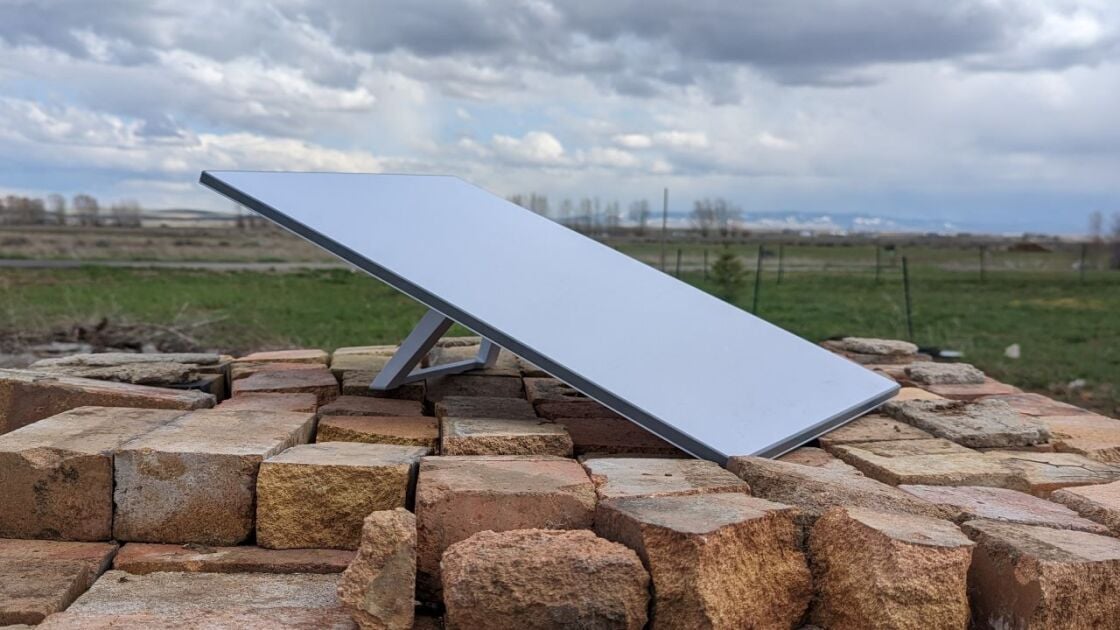After first reviewing the Dish V4 and Gen 3 router in 2024, I again tested the same equipment in 2025. Why? Because while the equipment is the same, Starlink’s infrastructure and technology is always improving. So, in our efforts to keep this review up to date with how Starlink currently performs, let’s look at the latest numbers and see what you can expect.
Below is a graph of my most recent Starlink upload/download testing in 2025, over a two-week period. (As mentioned earlier, the tests below reflect the performance of the standard residential equipment and don’t apply to Starlink Mini. To see how Starlink Mini performs, check out our full review.)
Mean download speeds increased from 148Mbps in 2024 to 177Mbps this year, a solid uptick in overall performance. Daily top speeds climbed higher than ever before, peaking at 315Mbps, the second-highest we’ve seen across years of testing, and consistently exceeding 200Mbps. But what really struck me was the lowest speed results—the slowest single measured speed in a given day. Download speeds fluctuate for all sorts of reasons, from network congestion to bad weather disrupting the signal to the satellites in space, but Starlink never dropped below 42Mbps during the full testing period, and stayed above 50Mbps the majority of the time. That’s a drastic improvement from the early days, when low speeds dipped as far down as 5Mbps. And it’s also significantly faster than other satellite internet providers, like HughesNet and ViaSat.
Measuring download and upload speeds is just part of the evaluation process. Those peak and average speeds only matter if they’re the speeds you’re actually experiencing, and if that performance is stable. Nobody cares how fast your internet registers in tests if your video feed keeps freezing up during work meetings.
To gauge consistency, we map out how many of our hundreds of test results fell within a given range, letting us see how regularly the performance delivers those speeds. In download and upload speed testing, we measure by Mbps, and we map out the result in 10Mbps increments. For latency, we measure ping response times in milliseconds (ms), again in intervals of 10. Higher numbers are better for uploads and downloads, while lower numbers are better for latency.
When we first reviewed the Dish V4, we saw download speeds clustered in the 150Mbps-to-180Mbps range, which was a substantial improvement over years past. But in our 2025 tests, we saw the grouping edge higher, with the majority of results falling between 140Mbps and 200Mbps, with equal numbers landing in the 160Mbps-to-170Mbps and 170Mbps-to-180Mbps ranges, indicating performance that’s not just occasionally faster but consistently faster.
Upload speeds have seen even more dramatic improvements, with test results now climbing as high as 64Mbps. While the majority of results fell within the 10Mbps-to-40Mbps range, our results show speeds consistently reaching above 30Mbps for the first time ever, far exceeding our expectations for high-speed uploads.
In terms of responsiveness, latency has achieved a new record low. Compared with last year, when most pings clustered between 20ms and 30ms, our 2025 data shows a definitive move to the 10ms-to-20ms range. This translates to near-instant responsiveness for real-time applications, from gaming to virtual meetings.
When breaking out the latency results by server—we test using both Cloudflare (1.1.1.1) and Google (8.8.8.8)—we saw a welcome change. For the first time, both providers showed similar, excellent sub-30ms latency.
In the past, the Google 8.8.8.8 server often showed slower responsiveness than Cloudflare’s, suggesting a potential bottleneck. However, the most recent testing has eliminated this discrepancy, with both Cloudflare and Google now reporting similar, consistently low sub-30ms latency.
Finally, when comparing raw averages across our annual Starlink tests, we saw that the latest Starlink V4 tests were consistently better than years past and even better than our 2024 tests.
Download speeds climbed steadily, getting a 17.7% boost from 2024, and nearly doubling the speeds I saw when we started testing Starlink in 2022.
Upload speeds have also improved by a similar margin, getting a 17.9% bump, and a full 175% improvement over the speeds I saw when I started testing Starlink. And latency is the best it’s ever been, dropping 6.63ms since just last year. That’s a massive improvement since 2022, when we measured the latency at 60ms and called it “more than quick enough for work and play.”
Given that Starlink requires blasting your internet activity to space and back, the latency has always been impressively low, but this is dramatically better than what we’ve seen before. It appears that SpaceX’s investment in improving every link in the Starlink chain, from ground stations to the satellites in space, continues to pay off.
This article was published by WTVG on 2025-10-17 06:00:00
View Original Post





